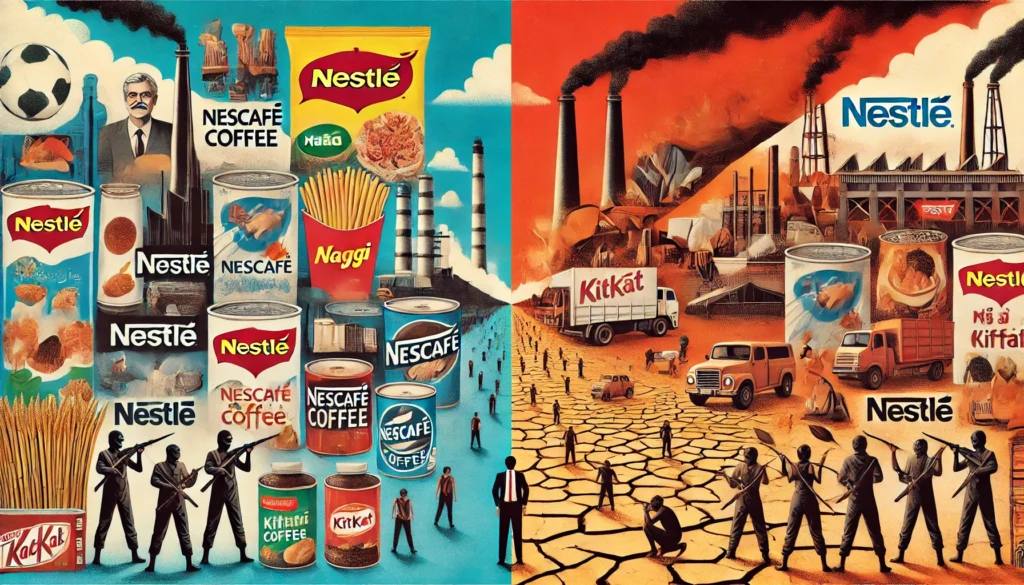Nestlé is a household name, known for its portfolio of brands across food, beverages, and consumer goods. With operations in nearly every corner of the globe, Nestlé epitomizes corporate dominance. But is there more to this global giant than meets the eye? In this in-depth case study, we’ll unravel the darker facets of Nestlé’s global strategy, examine its worldwide presence, and uncover the truths behind its astounding success.
Let’s dive deep into this strategic management journey, explore Nestlé’s achievements, challenges, and controversies, and uncover what truly drives its unmatched dominance.

Outline
The Shocking Truth Behind Nestlé’s Global Success
Introduction
Nestlé is much more than a name associated with chocolates and coffee. This Swiss multinational company boasts a history of innovation, an extensive global footprint, and some shocking tales behind its success. With over 2000 brands across 189 countries, it wields tremendous influence—but with great power comes controversy.
As we dissect Nestlé’s strategies, we’ll uncover its key success factors, including its ability to adapt globally while maintaining a unique hold in local markets. However, darker stories of environmental harm, child labor, and exploitative practices lurk in the shadows of this iconic corporation.
The Evolution of Nestlé: From Local to Global Giant
Nestlé began its journey in 1866 with a modest condensed milk factory in Switzerland. Its founder, Henri Nestlé, initially focused on infant nutrition. By 1905, Nestlé merged with the Anglo-Swiss Condensed Milk Company, setting the stage for worldwide expansion.
- Key Milestones in Growth:
- 1914–1945: Innovations in milk and chocolate products.
- 1950–1970: Expansion into frozen foods and culinary products.
- 1980–Present: Diversified into beverages, pharmaceuticals, and health sciences.
From Nescafé to Maggi, Nestlé continues to lead markets worldwide. Its knack for diversifying products while focusing on core competencies has been a cornerstone of its legacy.
Nestlé’s Global Strategy: A Blueprint for Dominance
At the heart of Nestlé's global success lies its ability to combine standardization with localization—a principle called glocalization. This ensures brand consistency globally while tailoring offerings to regional preferences.
- Core Strategies:
- Strategic Mergers & Acquisitions: The acquisition of brands like Purina and Gerber expanded Nestlé's reach.
- Adaptability: Maggi noodles, for instance, are flavored differently depending on local taste preferences.
- Focus on Emerging Markets: Heavy investment in markets like India, China, and Brazil.
Nestlé’s relentless pursuit of market relevance allows it to crush competitors while staying in tune with local cultures.
Nestlé’s Extensive Product Portfolio
Nestlé manages an enviable portfolio spanning from pet care to clinical nutrition. Popular Nestlé brands include:
- Beverages: Nescafé, Milo, and Nestea.
- Dairy: Nestlé Milk, Milkmaid.
- Convenience Foods: Maggi, KitKat, and Smarties.
- Infant Nutrition: Cerelac, Lactogen.
With every market it enters, Nestlé integrates staples with newer offerings to ensure seamless growth.
Nestlé in India: A Case Analysis
India is a cornerstone in Nestlé’s global strategy. Nestlé India’s share price reflects robust growth, driven by its stronghold in categories like instant noodles, coffee, and baby products.
- Major Products in India:
- Maggi Noodles: Reinvented the ready-to-eat market.
- Dairy: Milkmaid and Nestlé EveryDay.
- Beverages: Nescafé’s mass-market appeal.
Challenges in India: Nestlé faced backlash during the Maggi ban in 2015 when accusations of high lead content emerged. Yet, thanks to rapid brand rebuilding efforts, Maggi bounced back to reclaim 60% of the market share by 2018.
The Dark Side of Nestlé’s Business Practices
Though wildly successful, Nestlé has faced intense scrutiny for some controversial practices:
- Water Exploitation: The extraction of billions of liters of groundwater across developing countries sparked protests.
- Infant Formula Scandal: Aggressive marketing of formula over breastfeeding in developing nations drew global condemnation.
- Child Labor in Cocoa Supply Chains: Nestlé was accused of exploiting children to harvest cocoa beans in West Africa.
- Greenwashing Allegations: Nestlé’s claims of eco-friendliness often conflict with reports of high plastic waste.
These ethical dilemmas paint a different picture of the company’s meteoric rise.
The Financial Powerhouse: Nestlé’s Global Turnover
Nestlé consistently ranks among the world’s top corporations in terms of revenue. With a global turnover exceeding $95 billion (2023 figures), its financial clout allows it to dominate supply chains, negotiate favorable terms, and reinvest heavily into R&D.
- Regional Revenue Distribution:
- Europe and North America: Core markets with high profitability.
- Asia and Africa: Growth engines for the future.
Their strategy of blending mature markets with growth markets ensures balanced revenue streams.
Nestlé’s Approach to Sustainability and CSR
Nestlé claims sustainability is at its heart, launching initiatives like Nestlé for Healthier Kids and committing to reduce carbon emissions. However, its record has come under fire repeatedly, with environmentalists accusing it of greenwashing.
- Prominent campaigns like Planting a Million Trees have had limited tangible outcomes.
- Meanwhile, rising concerns about Nestlé’s reliance on plastic highlight the struggle between profit and environmental responsibility.
Key Takeaways from Nestlé’s Case Study
Nestlé’s unmatched scale of success stems from strategic adaptability, rigorous market research, and relentless expansion. But balancing profit with sustainability and ethics is proving to be an ongoing battle.
As future generations demand greater accountability from corporates, will Nestlé redefine its practices to remain relevant in a changing world? Only time will tell.
FAQs
1. Why is Nestlé successful globally?
Nestlé owes its success to aggressive innovation, product diversification, and its ability to adapt locally while expanding globally.
2. What was Nestlé’s Maggi controversy?
In 2015, Indian regulators found excessive lead in Maggi noodles. Though banned temporarily, the brand regained dominance following rigorous safety improvements.
3. What are the accusations against Nestlé?
Key allegations include water exploitation, child labor, unethical marketing, and insufficient environmental action.
4. How does Nestlé manage sustainability?
Nestlé promotes sustainability through initiatives in waste reduction, child nutrition, and carbon footprint reduction but often faces criticism for inadequate execution.
5. What are Nestlé India’s key products?
Maggi, Nescafé, Milkmaid, and Cerelac are among its flagship offerings.